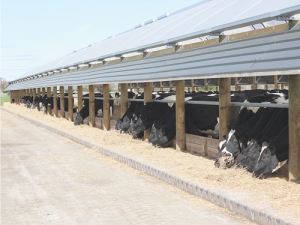Let's be more open about ag data
OPINION: The future of agricultural innovation is reliant on the sector being more open with its data.
 Herd Homes structures follow neither a traditional Kiwi grazing method or a traditional European housing method.
Herd Homes structures follow neither a traditional Kiwi grazing method or a traditional European housing method.
Averages are a great mathematical tool and brilliant for hiding poorer performing results because they get dragged up by higher results.
Unfortunately the reverse also happens: the top performing results get dragged down into the general population. This is fine when we are only interested in trends in the status quo, but the dairy industry today needs change.
The dairy industry faces a number of challenges – environmental, welfare and profitability to name a few.
But change is not driven by averages; it is driven by the statistical outliers – those farmers trying something different in all or part of their farming systems.
Trying to predict the future is not a perfect science but it is reasonable to expect that environmental standards will be tighter, and in particular N leaching limits will need to be lower, animal welfare standards will be increasingly monitored by the public and profitability needs to be maintained in the face of highly variable payout.
Production increases of 40% in the last two years (to 2200kg MS/ha), N leaching levels dropping 25%, grass harvest over 18t/ha, stocking rates of seven cows/ha with no pasture damage, costs under $3.00/kgMS, high yield crops produced solely on effluent, simple high input systems – these are statistical outliers hidden by the industry use of averages.
These statistical outliers are all being achieved on a number of farms with HerdHomes shelters and, as I’m sure, they are being achieved under different farm systems also.
These HerdHomes farms are following neither a traditional NZ grazing method nor a traditional European fully housed system; they are developing a hybrid system which utilises the best of both worlds by providing shelter to cows when necessary to protect the cows or pasture or both.
This allows the farmer to focus on efficiently growing and harvesting the highest tonnes of DM/ha possible. In a number of cases this is a mix of crop and pasture with pasture harvest yields higher due to a focus on limiting damage and maintaining the grass in an active growing stage. This is achieved by the cows themselves: giving them access to shelter during poor weather means they will leave the paddock themselves, saving the paddock from greater damage.
Having flexibility of feed options also means farmers can match demand far more evenly, and the cows use the feed more efficiently when out of the wet, cold or heat in some areas of the country.
Effluent capture is simple on these properties and is then treated as a valuable fertiliser resource, returned to the paddocks to maximise use of the nutrients and minimise environmental runoff. In a number of cases this reduces the need for any external phosphate or potash.
When wrapped together it can be a very efficient growing platform, recycling resources via feed efficient cows which allows strong profitability from a long term sustainable system.
Or of course you can be average.
• Hamish McMillan is the chief executive of Herd Homes.
President Donald Trump’s decision to impose tariffs on imports into the US is doing good things for global trade, according…
Seen a giant cheese roll rolling along Southland’s roads?
When American retail giant Cosco came to audit Open Country Dairy’s new butter plant at the Waharoa site and give…
An industry-wide project led by Ministry for Primary Industries (MPI) is underway to deal with the rising number of feral…
Fears of a serious early drought in Hawke’s Bay have been allayed – for the moment at least.